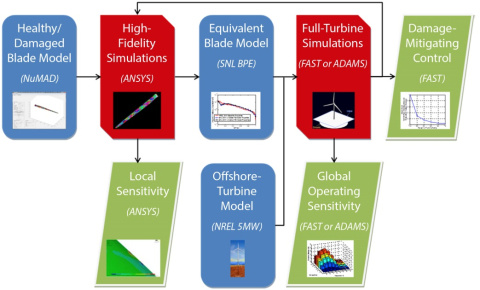Offshore wind energy could potentially play a significant role in helping the United States obtain an energy portfolio composed of clean, renewable, and diversified resources. One current obstacle to the utilization of offshore wind energy is that most projections put the operation and maintenance (O&M) costs of offshore wind farms between 2 to 5 times the current average costs for land-based wind farms. One way in which those costs may be reduced is through a simple yet effective structural health monitoring system as part of an overall condition-based maintenance paradigm. A successful health monitoring system would be able to reduce or eliminate unplanned or unnecessary maintenance as well as decrease logistic lead times and optimize supply chain management through the use of prognostics (predictive estimates of damage).
In March 2015, the U.S. Department of Energy’s Sandia National Laboratories (SNL) completed a 4-year research study on offshore wind plant structural health monitoring and prognostics management (SHPM). The study included major contributions from ATA Engineering, Purdue University, Georgia Tech, and Vanderbilt University.
The major results/findings of SNL’s SHPM project included:
- A roadmap for SHPM technology
- A multiple-scale damage modeling and simulation methodology
- Damage-detection strategies for common damage types (e.g., global operating sensitivity)
- A state-of-health of damaged turbines assessment (e.g., local sensitivity)
- The maturation of damage models for wind turbine blade analysis
- A demonstration of the benefits of smart loads management (e.g., damage mitigating controls) for wind turbine rotors
- Optimized maintenance processes
- SHPM economic calculations
- Damage-detection strategies that were tested under realistic and variable inflow conditions.
In addition to significant improvement in the O&M costs of wind turbines, an SHPM system can be used as an integral component of health-driven wind turbine control. Consequently, damage-mitigating control methodologies were investigated for smart turbine load management. These initial simulations revealed that derating a turbine power production by as little as 5% resulted in a reduction in the equivalent loading by 10% and a blade fatigue life extension of 300%. Therefore, if the health of a turbine is known, the power production of that turbine could be derated slightly to avoid costly unscheduled repairs and coordinate the lower-cost scheduled repair of many turbines. Although further research into the optimal damage-mitigating control methodologies is needed, it is evident that significant extensions of life can be achieved through small and simple changes in the turbine’s operation. Furthermore, these load management strategies could prove especially beneficial for offshore turbines where maintenance may be limited by the weather, and the increased possibility of servicing multiple turbines during a single visit to the wind plant may result in significantly reduced offshore O&M costs.
Read the full report, Structural Health and Prognostics Management for Offshore Wind Plants: Final Report of Sandia R&D Activities.

